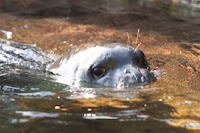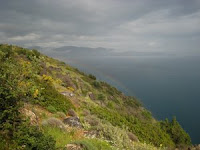
I thought the lack of sleep was going to be a major problem when I arrived to find we would be awake at 7am each day, but with the atmosphere of the other volunteers, Susie and Joan the sleep was soon forgotten… until the beautiful siesta in the afternoon. Waking up to the thought of your day being spent identifying dolphins and their behaviour, as well as the odd sea turtles (they are so cute!), was amazing. It was a dream I have always wanted to fulfil. You almost get to know the animals through the cropping and matching activities in the afternoon and feel as though you are helping them directly by conducting a part of the data collection for scientific research. I had never seen a dolphin before, not even at a zoo, so the size was what struck me, as well as the cheeky grin on their face. The evening lectures were really interesting and I learnt so much, which was helpful to supplement the work we completed on the field. The video on overfishing, even though I had seen it previously, has a strong message and impressed me once again. Susie and Joan were so nice! And made us feel like friends straight away which was helpful as the first day was really daunting. I spent the previous night in hotel Vonitsa whih was unbelievably friendly but also quite lonely because I have never travelled alone before but, once we all met and went back to the field station I felt completely at ease. Joan cracked jokes almost instantly which allowed us to speak freely and Susie was so incredibly supportive. Thank you so much for giving me this opportunity it was totally lifechanging and made me even more passionate about conservation and how you should never give up!
Anabelle, U.K.
---
This was certainly the most unique experience I have had in my life. As an environmental lawyer, it felt amazing to work so close to the nature as well as to learn about dolphins and other marine mammals. Being at the sea in the morning and seeing so many dolphins was great! In addition, helping with the cropping and matching made me feel like if I was part of this project. The presentations and films were very enriching and for sure will contribute to a better development of my profession as well as for my personal evolution. Besides these most obvious things, this expedition turned to be much more than I expected in many ways. The house is extremely cosy and Joan and Susie made us feel at home all the time! We have had so much fun at lunch and dinner! They are very special people! The team was very nice and of course, Posi is so cute! To sum up, everything was great! Thank you so much Joan and Susie! I will miss these days!
Patricia, Brasil
---
The scenery, the atmosphere and the people were all wonderful. Joan and Susie were both very helpful and great fun. We were made to feel right at home from the very beginning. The lectures were very informative and interesting. We learned a lot about the dolphins and other marine mammals. The dolphin sightings were amazing! We got to see a large group feeding very close to our boat and the dolphins really put on a great show for us. They are so cute. We were extra lucky and saw about 16 dolphins in Kalamos on the first day in that area where, unfortunately, it is rather normal not to see any dolphins at all. We helped Susie and Joan with the cropping and matching and it was a great feeling to be able to help in this way. The heat was quite intense for us Canadians but we learned to do "siesta" in the afternoon after the first couple of days. The food was amazing. Everybody had a turn at making the evening meals so we all had input in what we ate. We feel we had a very good group of ladies, and Joan and we were all able to work very well together and good fun. This was the greatest experience in our lifetime. Thank you to Joan and Susie for making this such a wonderful experience.
Jenna and Kim, Canada




















